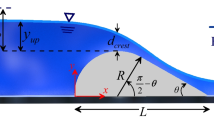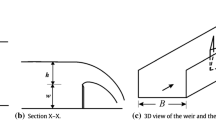Abstract
Weirs are important hydraulic structures widely used to control the flow rates in open channels and rivers. The discharge coefficient is a vital parameter in computing flow rate over weirs. In this work, we introduce the Walnut algorithm, a new nature-inspired optimization strategy. Then, it is combined with support vector regression (SVR) to predict the discharge coefficient parameter of triangular labyrinth weirs. The proposed Walnut-SVR method takes a set of observations as inputs specified by five non-dimensional features and attempts to find the discharge coefficient of unseen records. Walnut algorithm is proposed for feature selection, and optimum values of SVR parameters are found. The proposed method is evaluated using the Kumar dataset and compared with several counterpart methods. The results show the superiority of the Walnut-SVR method compared to other counterparts with \(R^2 =0.986\), \(RMSE= 0.004\), \(SI=0.006\), \(\sigma =0.858\), and \(NSE=0.981\) on test dataset. Feature analysis shows that the proposed method obtained the best results when three geometric parameters, the ratio of the weir crest length to the weir height (L/w), the ratio of head over the crest to the weir height (h/w), and the vertex angle (\(\theta \)) are used.






Similar content being viewed by others
Availability of data and material
There is no data for distribution.
References
Aydin MC (2016) Investigation of a sill effect on rectangular side-weir flow by using CFD. J Irrig Drain Eng 142(2):1–8
Aydin MC, Emiroglu ME (2013) Determination of capacity of labyrinth side weir by CFD. Flow Meas Instrum 29:1–8
Azimi H, Bonakdari H, Ebtehaj I (2019) Design of radial basis function-based support vector regression in predicting the discharge coefficient of a side weir in a trapezoidal channel. Appl Water Sci 9(4):1–12
Bagheri S, Heidarpour M (2010) Application of free vortex theory to estimating discharge coefficient for sharp-crested weirs. Biosyst Eng 105(3):423–427
Bijankhan M, Ferro V (2017) Dimensional analysis and stage-discharge relationship for weirs: a review. J Agric Eng 48(1):1–11
Bilhan O, Emiroglu E, Kisi O (2011) Use of artificial neural networks for prediction of discharge coefficient of triangular labyrinth side weir in curved channels. Adv Eng Softw 42(4):208–214
Bilhan O, Aydin CM, Emiroglu E, Miller CJ (2018) Experimental and CFD analysis of circular labyrinth weirs. J Irrig Drain Eng 144(6):1–11
Bonakdari H, Ebtehaj I, Gharabaghi B, Sharifi A, Mosavi A (2020) Prediction of discharge capacity of labyrinth weir with gene expression programming. In Proceedings of SAI Intelligent Systems Conference (pp. 202-217). Springer, Cham
Bonakdari H, Gharabaghi B, Ebtehaj I, Sharifi A (2020) A New Approach to estimate the discharge coefficient in sharp-crested rectangular side orifices using gene expression programming In Science and Information Conference (pp 77-96) Springer, Cham
Borghei SM, Parvaneh A (2011) Discharge characteristics of a modified oblique side weir in subcritical flow. Flow Meas Instrum 22(5):370–376
Brest J, Greiner S, Boskovic B, Mernik M, Zumer V (2006) Self-adapting control parameters in differential evolution: A comparative study on numerical benchmark problems. IEEE Trans Evol Comput 10(6):646–657
Cain ML, Milligan BG, Strand AE (2000) Long-distance seed dispersal in plant populations. Am J Bot 87(9):1217–1227
Chen Q, Liu B, Zhang Q, Liang J, Suganthan P, Qu B (2014) Problem definitions and evaluation criteria for CEC 2015 special session on bound constrained single-objective computationally expensive numerical optimization Technical Report Computational Intelligence Laboratory Zhengzhou University Zhengzhou China and Technical Report Nanyang Technological University
Contreras MA, Affleck D, Chung W (2011) Evaluating tree competition indices as predictors of basal area increment in western Montana forests. For Ecol Manag 262(11):1939–1949
Crookston BM, Tullis BF (2013) Hydraulic design and analysis of labyrinth weirs. I: discharge relationships. J Irrig Drain Eng 139(5):363–370
Derrac J, Garcia S, Molina D, Herrera F (2011) A practical tutorial on the use of nonparametric statistical tests as a methodology for comparing evolutionary and swarm intelligence algorithms. Swarm Evol Comput 1(1):3–18
Drucker H, Burges CJ, Kaufman L, Smola AJ, Vapnik V (1997) Support vector regression machines. Adv Neural Information Process Syst 155–161
Dutta D, Mandal A, Afzal MS (2020) Discharge performance of plan view of multi-cycle W-form and circular arc labyrinth weir using machine learning. Flow Meas Instrum 73:101740
Ebtehaj I, Bonakdari H (2016) A support vector regression-firefly algorithm-based model for limiting velocity prediction in sewer pipes. Water Sci Technol 73(9):2244–2250
Emami S, Arvanaghi H, Parsa J (2018) Numerical investigation of geometric parameters effect of the Labyrinth weir on the discharge coefficient. J Rehabil Civ Eng 6(1):1–9
Emami S, Parsa J, Emami H (2020) Estimation of discharge coefficient of curved plan-form labyrinth weirs using a Hybrid WOA-ANFIS method. Iranian J Irrig Drain 14(5):1664–1676
Emiroglu E, Kisi O (2013) Prediction of discharge coefficient for trapezoidal labyrinth side weir using a neuro-fuzzy approach. Water Resour Manag 27(5):1473–1488
Emiroglu ME, Kisi O, Bilhan O (2010) Predicting discharge capacity of triangular labyrinth side weir located on a straight channel by using an adaptive neuro-fuzzy technique. Adv Eng Softw 41(2):154–160
Ghodsian M (2009) Stage-discharge relationship for a triangular labyrinth spillway. Proc Inst Civil Eng Water Manag 162(3):173–178
Gholami A, Hossein B, Ali Akbar A, Isa E (2019) A combination of computational fluid dynamics, artificial neural network, and support vectors machines models to predict flow variables in curved channel. Scientia Iranica 26(2):726–741
Ghorbani MA, Haghi DZ, Azani A, Bonakdari H, Ebtehaj I (2017) Application of firefly algorithm-based support vector machines for prediction of field capacity and permanent wilting point. Soil Tillage Res 172:32–38
Gosling P (2007) Raising trees and shrubs from seed. Forestry Commission, Edinburgh
Gupta KK, Kumar S, Ahmad Z (2015) Effect of weir height on flow performance of sharp crested rectangular-planform weir. World Appl Sci 33(1):168–175
Haghiabi AH, Parsaie A, Ememgholizadeh S (2018) Prediction of discharge coefficient of triangular labyrinth weirs using adaptive neuro fuzzy inference system. Alexandria Eng J 57(3):1773–1782
Haupt RL, Ellen Haupt S (2004) Practical genetic algorithms. Wiley, Hoboken
Izadbakhsh M, Hajiabadi R (2019) Modeling discharge capacity of labyrinth weirs through a learning machine approach. J Appl Res Water Wastewater 12:100–108
Izadbakhsh M, Hajiabadi R (2020) Sensitizing influenced factors on discharge of labyrinth weirs using ANFIS model. J Appl Res Water Wastewater 7(1):1–13
Karaboga D, Akay B (2009) A comparative study of artificial bee colony algorithm. Appl Math Comput 214(1):108–132
Karami H, Karimi S, Bonakdari H (2016) Predicting discharge coefficient of triangular labyrinth weir using extreme learning machine, artificial neural network and genetic programming. Neural Comput Appl 29:983–989
Karimi S, Bonakdari H, Gholami A (2015) Determination discharge capacity of triangular labyrinth side weir using multi-layer neural network (ANN-MLP). Curr World Environ 10(1):111–119
Kumar S, Ahmad Z, Mansoor T (2011) A new approach to improve the discharging capacity of sharp-crested triangular plan form weirs. Flow Meas Instrum 22(3):175–180
Kumar S, Ahmad Z, Mansoor T, Himanshu SK (2013) A new approach to analyze the flow over sharp crested curved plan form weirs. IJRTE 2(1):24–28
Kumar M, Kulkarni AJ, Satapathy SC (2018) Socio evolution & learning optimization algorithm: a socio-inspired optimization methodology. Futur Gener Comput Syst 81:252–272
Lowman MD, Rinker HB (2004) Forest canopies, 2nd edn. Elsevier/Academic Press, Tokyo
Mahmoud A, Yuan X, Kheimi M, Yuan Y (2021) Interpolation accuracy of hybrid soft computing techniques in estimating discharge capacity of triangular labyrinth weir. IEEE Access 9:6769–6785
Mahmoud A, Yuan X, Kheimi M, Almadani MA, Hajilounezhad T, Yuan Y (2021) An Improved multi-objective particle swarm optimization with TOPSIS and fuzzy logic for optimizing trapezoidal labyrinth weir. IEEE Access 9:25458–25472
Mirjalili S, Mirjalili SM, Lewis A (2014) Grey wolf optimizer. Adv Eng Softw 69:46–61
Norouzi R, Daneshfaraz R, Ghaderi A (2019) Investigation of discharge coefficient of trapezoidal labyrinth weirs using artificial neural networks and support vector machines. Appl Water Sci 9(7):1–10
Norouzi P, Rajabi A, Izadbakhsh MA, Shabanlo S, Yosefvand F, Yaghoubi B (2020) A new non-tuned self-adaptive machine-learning approach for simulating the discharge coefficient of labyrinth weirs. Irrig Drain 69(3):398–416
Parsaie A, Haghiabi AH (2017) Improving modelling of discharge coefficient of triangular labyrinth lateral weirs using SVM, GMDH and MARS techniques. Irrig Drain 66(4):636–654
Raghavendra S, Deka P (2014) Support vector machine applications in the field of hydrology: a review. Appl Soft Comput 19:372–386
Roushangar K, Alami MT, Majedi Asl M (2017) Modeling discharge coefficient of normal and inverted orientation labyrinth weirs using machine learning techniques. ISH J Hydraul Eng 23(3):331–340
Safarrazavi Zadeh M, Esmaeili Varaki M, Biabani R (2021) Experimental study on flow over sinusoidal and semicircular labyrinth weirs. ISH J Hydraul Eng 27:304–313
Seamons TR (2014) Labyrinth weirs: a look into geometric variation and its effect on efficiency and design method predictions, Master of Science thesis, Utah State University, USA
Shafiei S, Najarchi M, Shabanlou S (2020) A novel approach using CFD and neuro-fuzzy-firefly algorithm in predicting labyrinth weir discharge coefficient. J Brazilian Soc Mech Sci Eng 42(44):1–19
Shafiei Sh, Najarchi M, Shabanlou S (2020) Prognostication of discharge coefficient of labyrinth weir using outlier robust extreme learning machine. Flow Meas Instrum 71:101681
Shaghaghian MR, Sharifi MT (2015) Numerical modeling of sharp-crested triangular plan form weirs using FLUENT. Indian J Sci Techno 8(34):1–7
Sharafi H, Ebtehaj I, Bonakdari H (2016) Design of a support vector machine with different kernel functions to predict scour depth around bridge piers. Nat Hazards 84:2145–2162
Suganthan PN, Hansen N, Liang JJ, Deb K, Chen YP, Auger A, Tiwari S (2005) Problem definitions and evaluation criteria for the CEC 2005 special session on real-parameter optimization. KanGAL Rep 2005005:2005
Thangaraj R, Pant M, Abraham A, Bouvry P (2011) Particle swarm optimization: hybridization perspectives and experimental illustrations. Appl Math Comput 217(12):5208–5226
Yaghoubi B, Izadbakhsh M (2019) Predicting discharge coefficient of triangular plan form weirs using hybrid model based on fuzzy systems and differential evolution algorithm. J Dam Hydroelectric Powerplant 6(22):1–12
Zaji AH, Bonakdari H, Karimi S (2015) Radial basis neural network and particle swarm optimization-based equations for predicting the discharge capacity of triangular labyrinth weirs. Flow Meas Instrum 45:341–347
Zaji AH, Bonakdari H, Khodashenas SR (2016) Firefly optimization algorithm effect on support vector regression prediction improvement of a modified labyrinth side weir’s discharge coefficient. Appl Math Comput 274:14-19
Zeynoddin M, Bonakdari H, Ebtehaj I, Esmaeilbeiki F, Gharabaghi B, Haghi DZ (2019) A reliable linear stochastic daily soil temperature forecast model. Soil Tillage Res 189:73–87
Funding
There is no funding information.
Author information
Authors and Affiliations
Contributions
This paper presents a new swarm intelligence method, namely Walnut optimization algorithm. This algorithm obtains better performance compared with other optimization algorithms. The algorithm applied to discharge coefficient prediction on labyrinth weirs.
Corresponding author
Ethics declarations
Conflict of interest
H. Emami declares that he has no conflict of interest.
Code availability
The source code will be published if the paper is accepted.
Ethical approval
This article does not contain any studies with human participants or animals performed by any of the authors.
Additional information
Publisher's Note
Springer Nature remains neutral with regard to jurisdictional claims in published maps and institutional affiliations.
Rights and permissions
About this article
Cite this article
Emami, H., Emami, S. & Parsa, J. A Walnut optimization algorithm applied to discharge coefficient prediction on labyrinth weirs. Soft Comput 26, 12197–12215 (2022). https://doi.org/10.1007/s00500-022-07041-8
Accepted:
Published:
Issue Date:
DOI: https://doi.org/10.1007/s00500-022-07041-8




